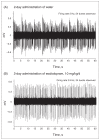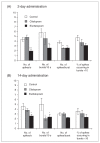Effects of sustained serotonin reuptake inhibition on the firing of dopamine neurons in the rat ventral tegmental area - PubMed (original) (raw)
Effects of sustained serotonin reuptake inhibition on the firing of dopamine neurons in the rat ventral tegmental area
Eliyahu Dremencov et al. J Psychiatry Neurosci. 2009 May.
Abstract
Background: Selective serotonin (5-HT) reuptake inhibitors (SSRIs) are efficacious in depression because of their ability to increase 5-HT neurotransmission. However, owing to a purported inhibitory effect of 5-HT on dopamine (DA) neuronal activity in the ventral tegmental area (VTA), this increase in 5-HT transmission might result in a suppression of the firing activity of DA neurons. Since the mesolimbic DA system plays an important role in motivation and reward, a potential decrease in the firing of DA neurons may lead, in some patients, to a lack of adequate response to SSRIs.
Methods: We administered the SSRIs citalopram or escitalopram in rats. We determined DA neuronal activity using in-vivo electrophysiology.
Results: Sustained administration of escitalopram robustly decreased the firing rate and burst activity of DA neurons. There was no difference in the mean number of spontaneously active DA neurons per tract among the 3 groups (citalopram, escitalopram, control). This inhibition was reversed by the selective 5-HT(2C) receptor antagonist SB 242084. Citalopram, however, did not alter the overall firing rate but inhibited the burst activity of DA neurons.
Limitations: Our experiments were carried out with the rats under general anesthesia. Therefore, under such conditions the absolute changes produced by SSRIs may heve been different from those occurring in freely moving rats. The exact location of the 5-HT(2C) receptors mediating the inhibitory effects of the SSRIs could not be determined in these studies.
Conclusion: The difference between escitalopram and citalopram in their effect on DA neuronal activity may be explained by the higher efficacy of escitalopram as a 5-HT reuptake inhibitor. Since the inhibitory effect of escitalopram on DA neuronal activity is mediated via 5-HT(2C) receptors, antagonists of these receptors might be effective adjuncts in SSRI-resistant depression.
Contexte: Les ISRS, ou inhibiteurs sélectifs du recaptage de la sérotonine (5-HT), sont efficaces dans la dépression en raison de leur capacité d’accroître la neurotransmission sérotoninergique. Toutefois, compte tenu d’un présumé effet inhibiteur de la 5-HT sur l’activité dopaminergique dans l’aire tegmentaire ventrale, cette transmission sérotoninergique accrue pourrait entraîner un ralentissement de la fréquence de décharge des neurones dopaminergiques. Étant donné que le système dopaminergique mésolimbique joue un rôle important dans la motivation et la gratification, un ralentissement potentiel de la fréquence de décharge des neurones dopaminergiques pourrait empêcher une réponse incomplète aux ISRS chez certains patients.
Méthodes: Nous avons administré les ISRS citalopram ou escitalopram à des rats. Nous avons enregistré in vivo l’activité éléctrophysiologique des neurones dopaminergiques.
Résultats: L’administration soutenue d’escitalopram a nettement ralenti la fréquence de décharge et diminué l’activité en salve des neurones dopaminergiques. On n’a noté aucune différence quant au nombre moyen de neurones dopaminergiques spontanément actifs parmi les 3 groupes (citalopram, escitalopram, témoins). Cette inhibition a été renversée par le SB242084, un antagoniste sélectif des récepteurs 5-HT2C. Le citalopram n’a cependant pas modifié la fréquence globale de décharge, mais a inhibé l’activité en salve des neurones dopaminergiques.
Limites: Nos expériences ont été effectuées chez des rats sous anesthésie générale. Compte tenu de cette condition, les changements absolus générés par les ISRS pourraient être différents de ce qui s’observerait chez des rats éveillés. Ces expériences ne démontrent pas la localisation des récepteurs 5-HT2C modulant les effets inhibiteurs des ISRS.
Conclusion: La différence entre l’escitalopram et le citalopram pour ce qui est de leur effet sur l’activité neuronale dopaminergique pourrait s’expliquer par l’inhibition plus grande du escitalopram sur le recaptage de la 5-HT. Étant donné que l’effet inhibiteur du escitalopram sur l’activité neuronale dopaminergique est modulé par les récepteurs 5-HT2C, les antagonistes de ces récepteurs pourraient être efficaces en traitement d’appoint dans la dépression résistante aux ISRS.
Figures
Fig. 1
Representative single-unit extracellular recordings from the ventral tegmental area dopamine neurons in (A) a control rat that received water and (B) in a rat that received 10 mg/kg/d of escitaloram for 2 days.
Fig. 2
Lack of the effect of acute administration of escitalopram on the firing activity of dopamine neurons. The animals (n = 5) were consecutively given (intravenously) escitalopram at the doses from 0.5 to 5.0 mg/kg. The firing rates and burst activity (mean and standar error of the mean) are presented. The higher doses of escitalopram could not be tested because of their lethal effect on animals.
Fig. 3
Effects of citalopram and escitalopram administration on the dopamine neuronal firing rate in the ventral tegmental area. The rats were implanted with minipumps containing vehicle (water), citalopram (20 mg/kg/d) and escitalopram (10 mg/kg/d) for (A) 2 and (B) 14 days. The firing rates and burst activity (mean and standard error of the mean) are presented. Multivariate analysis of variance showed a significant difference between the groups. For 2 days: Wilks Λ = 0.22, F 8,94 = 12.91, p < 0.001, firing rate F = 13.19, p < 0.001; number of bursts/10 s F = 6.95, p < 0.01; number of spikes/burst F = 9.62, p < 001; for 14 days: Wilks Λ = 0.59, _F_8,84 = 12.91, p < 0.01, firing rate F = 4.50, p < 0.05, number of bursts/10 s F = 4.39, p < 0.05, number of spikes/burst F = 3.37, p < 0.05). *p < 0.05, **p < 0.01 and ***p < 0.001 in comparison with vehicle, Bonferroni post-hoc test.
Fig. 4
Effect of SB 242084 administration on the dopamine neuronal firing rate in the ventral tegmental area. The selective 5-HT2C receptor antagonist SB 242084 was given (0.5 and 2.0 mg/kg/d for 2 days, subcutaneously) to rats that received (A) vehicle and (B) escitalopram. The firing rates and burst activity (mean and standard error of the mean [SEM]) are presented. The ranges of control animals are shown using dotted lines (mean−SEM, bottom line; mean+SEM, upper line). When SB 242084 was coadministered with escitalopram, multivariate analysis of variance showed significant difference between the groups: Wilks Λ = 0.53, _F_12,196 = 4.38, p < 0.001, firing rate F = 5.83, p = 0.001; number of spikes/burst F = 12.47, p < 001, proportion of spikes occurring in bursts F = 3.22, p < 0.05). *p < 0.05 and ***p < 0.001 in comparison with vehicle; #p < 0.05 in comparison with escitalopram, Bonferroni post-hoc test.
Similar articles
- Effects of S-citalopram, citalopram, and R-citalopram on the firing patterns of dopamine neurons in the ventral tegmental area, N-methyl-D-aspartate receptor-mediated transmission in the medial prefrontal cortex and cognitive function in the rat.
Schilström B, Konradsson-Geuken A, Ivanov V, Gertow J, Feltmann K, Marcus MM, Jardemark K, Svensson TH. Schilström B, et al. Synapse. 2011 May;65(5):357-67. doi: 10.1002/syn.20853. Epub 2010 Sep 24. Synapse. 2011. PMID: 20730799 - Serotonin-2C antagonism augments the effect of citalopram on serotonin and dopamine levels in the ventral tegmental area and nucleus accumbens.
Visser AK, Kleijn J, van Faassen MH, Dremencov E, Flik G, Kema IP, Den Boer JA, van Waarde A, Dierckx RA, Bosker FJ. Visser AK, et al. Neurochem Int. 2015 Feb;81:10-5. doi: 10.1016/j.neuint.2014.12.006. Epub 2014 Dec 24. Neurochem Int. 2015. PMID: 25542858 - Effects of acute and long-term administration of escitalopram and citalopram on serotonin neurotransmission: an in vivo electrophysiological study in rat brain.
El Mansari M, Sánchez C, Chouvet G, Renaud B, Haddjeri N. El Mansari M, et al. Neuropsychopharmacology. 2005 Jul;30(7):1269-77. doi: 10.1038/sj.npp.1300686. Neuropsychopharmacology. 2005. PMID: 15702136 - [Escitalopram: a selective inhibitor and allosteric modulator of the serotonin transporter].
Mnie-Filali O, El Mansari M, Scarna H, Zimmer L, Sánchez C, Haddjeri N. Mnie-Filali O, et al. Encephale. 2007 Dec;33(6):965-72. doi: 10.1016/j.encep.2007.11.001. Epub 2007 Dec 11. Encephale. 2007. PMID: 18789789 Review. French. - The roles of dopamine and serotonin, and of their receptors, in regulating sleep and waking.
Monti JM, Jantos H. Monti JM, et al. Prog Brain Res. 2008;172:625-46. doi: 10.1016/S0079-6123(08)00929-1. Prog Brain Res. 2008. PMID: 18772053 Review.
Cited by
- CCNP Innovations in Neuropsychopharmacology Award: The psychopharmacology of psychedelics: where the brain meets spirituality.
Gobbi G. Gobbi G. J Psychiatry Neurosci. 2024 Sep 19;49(5):E301-E318. doi: 10.1503/jpn.240037. Print 2024 Sep-Oct. J Psychiatry Neurosci. 2024. PMID: 39299781 Free PMC article. Review. - AMPA receptors modulate enhanced dopamine neuronal activity induced by the combined administration of venlafaxine and brexpiprazole.
Daniels S, El Mansari M, Blier P. Daniels S, et al. Neuropsychopharmacology. 2024 Dec;49(13):2042-2051. doi: 10.1038/s41386-024-01958-4. Epub 2024 Aug 15. Neuropsychopharmacology. 2024. PMID: 39147870 Free PMC article. - Direct serotonin release in humans shapes aversive learning and inhibition.
Colwell MJ, Tagomori H, Shang F, Cheng HI, Wigg CE, Browning M, Cowen PJ, Murphy SE, Harmer CJ. Colwell MJ, et al. Nat Commun. 2024 Aug 9;15(1):6617. doi: 10.1038/s41467-024-50394-x. Nat Commun. 2024. PMID: 39122687 Free PMC article. - SSRIs in the Treatment of Depression: A Pharmacological CUL-DE-SAC?
Cowen PJ. Cowen PJ. Curr Top Behav Neurosci. 2024;66:1-19. doi: 10.1007/7854_2023_447. Curr Top Behav Neurosci. 2024. PMID: 37922101 Review. - Dopamine in major depressive disorder: A systematic review and meta-analysis of in vivo imaging studies.
Mizuno Y, Ashok AH, Bhat BB, Jauhar S, Howes OD. Mizuno Y, et al. J Psychopharmacol. 2023 Nov;37(11):1058-1069. doi: 10.1177/02698811231200881. Epub 2023 Oct 9. J Psychopharmacol. 2023. PMID: 37811803 Free PMC article.
References
- Ravindran L, Kennedy SH. Are antidepressants as effective as claimed? Yes, but…. Can J Psychiatry. 2007;52:98–9. discussion 100–1. - PubMed
- El Mansari M, Sanchez C, Chouvet G, et al. Effects of acute and long-term administration of escitalopram and citalopram on serotonin neurotransmission: an in vivo electrophysiological study in rat brain. Neuropsychopharmacology. 2005;30:1269–77. - PubMed
- Szabo ST, Blier P. Response of the norepinephrine system to anti-depressant drugs. CNS Spectr. 2001;6:679–84. - PubMed
- Dremencov E, El Mansari M, Blier P. Noradrenergic augmentation of escitalopram response by risperidone: electrophysiologic studies in the rat brain. Biol Psychiatry. 2007;61:671–8. - PubMed
- Dremencov E, El Mansari M, Blier P. Distinct electrophysiological effect of paliperidone and risperidone on the firing activity of rat serotonin and norepinephrine neurons. Psychopharmacology (Berl) 2007;194:63–72. - PubMed
Publication types
MeSH terms
Substances
LinkOut - more resources
Full Text Sources



